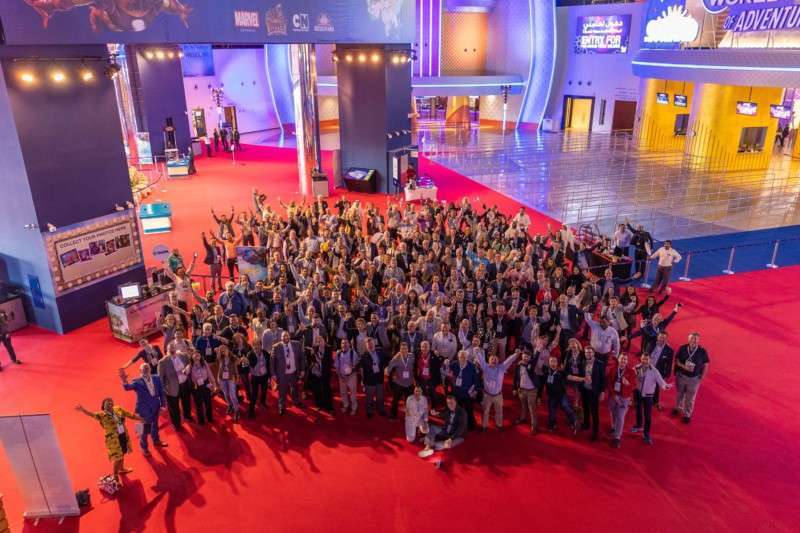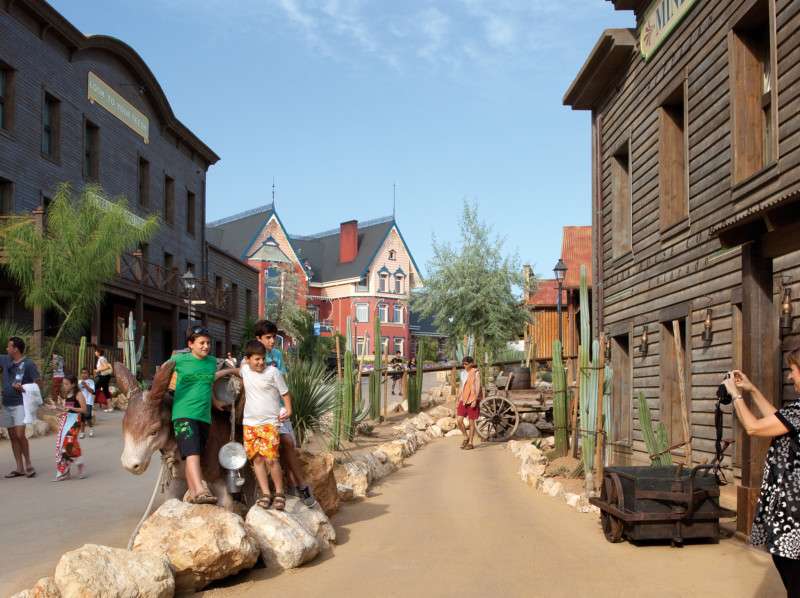by Jeff Havlik (vice president), Carol Breeze (exhibit designer) and Steve Mohesky (visualization designer) of PGAV Destinations
ABOVE: PGAV has helped develop PortAventura since its creation in the early 90s. Photo courtesy PGAV
The limitless potential of partnerships crosses oceans, crosses borders, and ferries us all – together – into the future of themed entertainment. Without this collaboration, we only grow more distant and fractured. In the attractions industry, the best practices we now enjoy in terms of partnerships and amicable collaborations took time to evolve. It took decades of learning, growth, and proven success for cross-skillset, cross-institution, and even cross-country teamwork to become a key ingredient in today’s themed entertainment innovation.
In the early 1990s, PGAV was endeavoring into its first international foray: developing Port Aventura from the ground-up, in Salou, Spain. The experience set a precedent for decades to come – experimentation with new technologies, in depth market research, how to meet new and lifelong partners, and the thrill of shared learning with a team possessing a completely different worldview.
Partnering Abroad
On the macro-scale, the growth of ground-up destinations in the United States has slowed in recent decades, focusing more on expansions and enhancements. However, across the globe we find the fast-paced development of numerous larger destinations arising from mountain foothills, seaside vistas, or what was once farmland. For many design firms that aren’t licensed to practice architecture in many of these economic take-off countries, partnerships are an absolute necessity. To be successful on the international stage requires several different partnerships:
Client: The client is certainly the central partnership, offering irreplaceable insights into the needs for their particular site.
Local Architects: These teams understand governmental policies, regional code requirements, and the varying means and methods of construction in the country.
Sub-Consultants: Just as with the local architects, these teams have specific knowledge of their culture’s approach to development and construction.
Suppliers: These resident teams have the ability and know-how to navigate supply chain and logistics to provide the equipment, rides, and more that relate to the international destinations.

Partnering abroad is a unique, thrilling experience. Throughout the United States, although there are certainly varying company cultures and management styles, our attractions industry has relatively set ways in operating destinations, developing projects, and managing teams. Once the passport has been re-pocketed though, it’s an exciting time to learn brand new ways of doing business. It’s a two-way flow of information: showcasing best practices from America that international clients may have never considered, and learning the successful practices from abroad – and oftentimes the even more fascinating, brilliantly complex, or culturally straight-forward rationale behind those practices. These insights have, without exaggeration, changed our entire perspective on projects and destination development.
Finding Friends Afar
These partnerships don’t magically happen. Although an internet search can be a starting point, the strongest partnerships form from meeting individuals one-on-one. One of the ideal settings to meet these future partners has been at international symposiums and conferences from the myriad IAAPA & TEA events, global Zoo and Aquarium events, and more unique events such as the recent Connected Audience conference in Berlin. But simply showing up and networking these events is not enough. Serving on committees, attending symposiums, and participating in forums and workshops leads to personal connections with owners, operators, and yes – competitors, that often turn into partnerships. Additionally, PGAV presents in sessions as often as possible. It’s an opportunity to share our lessons with the global community and broadcast our values and interests, which leads to meeting like-minded people to form long-lasting partnerships.
It’s obvious we find these industry events important to forming partnerships. Our designers believe it’s essential that institutions invest in these conferences, if they are able. Beyond our own attendance, it’s important to find opportunities to financially support expos with sponsorship, which often bolster internal as well as industry-wide strategies. Stakeholder companies (e.g. all of us) must ensure that these events, especially new and growing events in emerging markets, are successful and long-lasting. The relationships they spawn strengthen the international attractions design community, and therefore the global entertainment industry.
Our partnership with the global entertainment industry extends beyond the participation and support of industry organizations. For over 15 years, we’ve published our quarterly Destinology and annual research projects containing essential insights into attraction guest behavior and destination best practices. Destinology, Voice of the Visitor, Inspiration from Nature, and even the brand new Welcome! Profile of International Guests to America are the result of partnerships with clients, operators, and researchers. We bring the greatest wisdom and lessons from our partners and distill them into these reports, initiate primary research to discover guests’ patterns, demographics, motivations, behaviors, and trends, and freely distribute these to the global entertainment industry.
Go Forth and Learn
Building strong international partnerships and successful projects takes empathy through an understanding of the culture that goes beyond the meeting room. Five years ago, we introduced “PGAV GO!,” a self-directed professional development program where staff are allotted an annual fund to invest in themselves however they choose. Although the opportunities are broad, more than 80% of the funds are expended on traveling the world. This empowers our staff to be guests, tourists, and researchers, which brings unique and ever-advancing insights into the world’s cultures through personal experiences and insights as a guest. This quest for experience pays limitless dividends for our partnerships and project work. Cultural familiarity extends beyond the project executive that travels to the site, to each person on the team solidifying partnerships through empathy.
How to be Together in Technology
Pop culture science fiction technological promises are starting to show up in our lives. Virtual Reality, Augmented Reality, and Artificial Intelligence influence the expectation of attraction guests, destination managers, and themed entertainment designers. We’re thrilled by the prospect of these tools and their possibilities to blend story worlds, allow us to design in real time, and connect our teams with other experts around the world through a virtual environment, but the reality doesn’t quite yet meet the virtual reality. It solves some problems, yet creates new ones. It is through our partnerships that we work toward empowering the technology to bring us together.
Our internal Innovation Group scans the horizon beyond the themed entertainment industry, scrapes the internet and Twitter for new products and evolutions, and passionately debates innovation and technology. The team meets with software developers from around the world, discussing the challenges they see coming in the future, and collaborating to imagine what software could solve those challenges when they arrive.
New technological discoveries are often a grassroots effort, essential to a culture of innovation: an individual uncovers an opportunity that thrills them, and they bring it to the Innovation Group. The team evaluates whether these new programs can work seamlessly with other programs throughout the design process, and whether they apply to design and modeling, rendering, animation, and/or the tools used to share design concepts. It’s rarely a goal to replace tools – designers will always use ink and clay – but it’s about enhancing the existing toolbelt.
The most exciting way to explore a new technology is to find a client who’s comfortable and excited to have it tested on their own project. Never use new technology just for the sake of using it: use the right tool for the right job. Sometimes this comfort level is reflective of the resources a park has available to it, while sometimes it’s ingrained in a country’s culture – accustomed to, or almost expecting, 3D immersion and gaming capabilities. The process of design with the client is an exciting frontier regarding AR/VR technologies. PGAV’s new Highly Immersive Virtual Environment (HIVE) is a dedicated catalyst lab for our designers to explore new technologies, as they meet with clients to explore projects in an immersive opportunity. That frontier is aimed at developing even more ways to digitally collaborate with our clients in real time, whether we’re across time zones, all at a digital table adjusting a beautiful rendering, or standing in a virtual environment, adjusting lighting, color, and environments immediately with the adept flourish of a tilt-brush.
Beyond design, AR and VR are on track to merge together and create new and intriguing guest experiences. In our Destinology research, a key motivator for attraction visitation is always, “to have fun together.” The technological challenge is that often VR is an isolating experience: we put on our headset, and we no longer see the looks of surprise and joy on our children’s faces. Haptic vests, interactive spaces, or digital devices that provide further information on exhibits and animals are all evolving in a similar direction, bound to merge eventually – and our collaborative R&D is essential to bring us all there together.
Evolving from Tradition to Together
These incredible global partnerships have mandated that a traditional destination design firm must evolve and broaden its abilities. It must become a foundational business consultant, analyzing the business and existing products from the very beginning, to develop strategies that may have no relation to attraction design. It must be an adept market research firm, near-obsessed with psychology, social behavior, pop culture, empathy, and guest insights. It must be a cutting-edge R&D lab, ever horizon-scanning, experimenting, fearless in risk-taking, and reliant on trial and error. It must expand its services beyond the traditional up-front concepting, delving into construction documents, the disciplines within lead design consultancy, tendering the project, reviewing bids, construction administration, leading art direction – even living on site for years to make that all happen. But this all must be done together, in a collaborative partnership.
Because we are all better together. • • •






